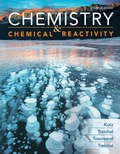
Concept explainers
(a)
Interpretation: Probable mode of decay of manganese-54 and the equation for this radioactive decay has to be given
Concept introduction:
Radioactive decay: It is the process in which a radioactive nucleus loses its energy by the emission of radiations namely, beta particle, alpha particle
Common particles in radioactive decay and nuclear transformations are mentioned below,
There are various types of nuclear processes. The changes in
(a)
Explanation of Solution
The radioactive isotope of manganese-54 is transmuted to iron-56 along with the emission of a proton.
The equation for this radioactive decay is given below:
(b)
Interpretation: Probable mode of decay of silver-110 and the equation for this radioactive decay has to be given
Concept introduction:
Radioactive decay: It is the process in which a radioactive nucleus loses its energy by the emission of radiations namely, beta particle, alpha particle
Common particles in radioactive decay and nuclear transformations are mentioned below,
There are various types of nuclear processes. The changes in atomic number and mass number accompanying radioactive decay are mentioned below,
(b)
Explanation of Solution
The radioactive isotope of silver-110 is transmuted to cadmium-110 along with the emission of a beta particle.
The equation for this radioactive decay is given below:
(c)
Interpretation: Probable mode of decay of americium-241 and the equation for this radioactive decay has to be given
Concept introduction:
Radioactive decay: It is the process in which a radioactive nucleus loses its energy by the emission of radiations namely, beta particle, alpha particle
Common particles in radioactive decay and nuclear transformations are mentioned below,
There are various types of nuclear processes. The changes in atomic number and mass number accompanying radioactive decay are mentioned below,
(c)
Explanation of Solution
The radioactive isotope of americium-241 is transmuted to neptunium-237 along with the emission of an alpha particle.
The equation for this radioactive decay is given below:
(d)
Interpretation: Probable mode of decay of mercury-197m and the equation for this radioactive decay has to be given
Concept introduction:
Radioactive decay: It is the process in which a radioactive nucleus loses its energy by the emission of radiations namely, beta particle, alpha particle
Common particles in radioactive decay and nuclear transformations are mentioned below,
There are various types of nuclear processes. The changes in atomic number and mass number accompanying radioactive decay are mentioned below,
(d)
Explanation of Solution
The radioactive isotope mercury-197m is first converted to mercury-197. Then the radioactive isotope mercury-197 is transmuted to gold-197.
The equation for this radioactive decay is given below:
Want to see more full solutions like this?
Chapter 25 Solutions
Chemistry & Chemical Reactivity
- drawing, no aiarrow_forwardDraw the major organic product when each of the bellow reagents is added to 3,3-dimethylbutere. ✓ 3rd attempt Part 1 (0.3 point) H.C CH CH + 1. BHG THF 210 NaOH NJ 10000 Part 2 (0.3 point) HC- CH HC 2741 OH a Search 1. He|DA HO 2. NIBH さ 士 Ju See Periodic Table See Hint j = uz C H F F boxarrow_forwardSynthesis of 2-metilbenzimidazol from 1,2-diaminobenceno y propanona.arrow_forward
- Predict the product of the following reaction. 1st attempt HI 1 product 50300 Jul See Periodic Table See Hint P Br 石尚 Iarrow_forwardIndicate the substitutes in one place, if they are a diazonio room.arrow_forwardIndicate the product formed in each reaction. If the product exhibits tautomerism, draw the tautomeric structure. a) о + CH3-NH-NH2 CO2C2H5 b) + CoH5-NH-NH2 OC2H5arrow_forward
- Indicate the formula of the compound, that is the result of the N- alquilación (nucleofílic substitution), in which an additional lateral chain was formed (NH-CH2-COOMe). F3C. CF3 NH NH2 Br о OMe K2CO3, DABCO, DMFarrow_forwardSynthesis of 1-metilbenzotriazole from 1,2-diaminobenceno.arrow_forwardSynthesis of 1-metilbenzotriazole.arrow_forward
 Chemistry & Chemical ReactivityChemistryISBN:9781337399074Author:John C. Kotz, Paul M. Treichel, John Townsend, David TreichelPublisher:Cengage Learning
Chemistry & Chemical ReactivityChemistryISBN:9781337399074Author:John C. Kotz, Paul M. Treichel, John Townsend, David TreichelPublisher:Cengage Learning Chemistry & Chemical ReactivityChemistryISBN:9781133949640Author:John C. Kotz, Paul M. Treichel, John Townsend, David TreichelPublisher:Cengage Learning
Chemistry & Chemical ReactivityChemistryISBN:9781133949640Author:John C. Kotz, Paul M. Treichel, John Townsend, David TreichelPublisher:Cengage Learning Principles of Modern ChemistryChemistryISBN:9781305079113Author:David W. Oxtoby, H. Pat Gillis, Laurie J. ButlerPublisher:Cengage Learning
Principles of Modern ChemistryChemistryISBN:9781305079113Author:David W. Oxtoby, H. Pat Gillis, Laurie J. ButlerPublisher:Cengage Learning General Chemistry - Standalone book (MindTap Cour...ChemistryISBN:9781305580343Author:Steven D. Gammon, Ebbing, Darrell Ebbing, Steven D., Darrell; Gammon, Darrell Ebbing; Steven D. Gammon, Darrell D.; Gammon, Ebbing; Steven D. Gammon; DarrellPublisher:Cengage Learning
General Chemistry - Standalone book (MindTap Cour...ChemistryISBN:9781305580343Author:Steven D. Gammon, Ebbing, Darrell Ebbing, Steven D., Darrell; Gammon, Darrell Ebbing; Steven D. Gammon, Darrell D.; Gammon, Ebbing; Steven D. Gammon; DarrellPublisher:Cengage Learning Chemistry: Principles and PracticeChemistryISBN:9780534420123Author:Daniel L. Reger, Scott R. Goode, David W. Ball, Edward MercerPublisher:Cengage Learning
Chemistry: Principles and PracticeChemistryISBN:9780534420123Author:Daniel L. Reger, Scott R. Goode, David W. Ball, Edward MercerPublisher:Cengage Learning Chemistry for Today: General, Organic, and Bioche...ChemistryISBN:9781305960060Author:Spencer L. Seager, Michael R. Slabaugh, Maren S. HansenPublisher:Cengage Learning
Chemistry for Today: General, Organic, and Bioche...ChemistryISBN:9781305960060Author:Spencer L. Seager, Michael R. Slabaugh, Maren S. HansenPublisher:Cengage Learning





